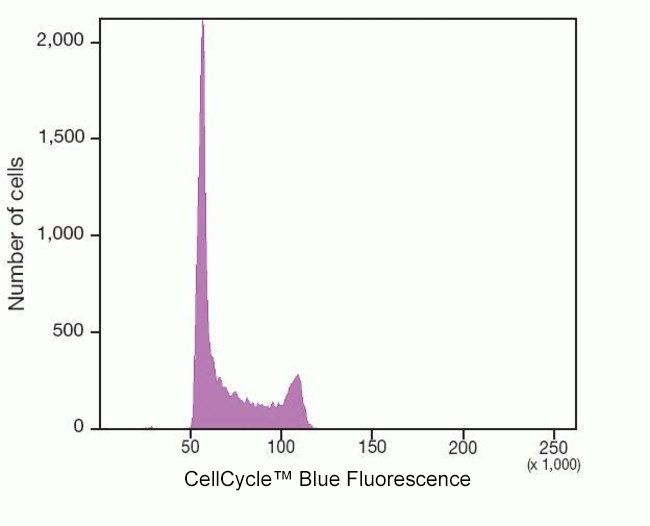Live cell studies of cellular DNA content and cell cycle distribution are useful to detect variations of growth patterns due to a variety of physical, chemical, or biological means, to monitor apoptosis, and to study tumor behavior and suppressor gene mechanisms. In a given population, cells are distributed among three major phases of cell cycle: G0/G1 phase (one st of paired chromosomes per cell), S phase (DNA synthesis with variable amount of DNA), and G2/M phase (two sets of paired chromosomes per cell, prior to cell division). DNA content can be measured using fluorescent, DNA-selective stains that exhibit emission signals proportional to DNA mass. Flow cytometric analysis of these stained populations is then used to produce a frequency histogram that reveals the various cell cycle phases. This analysis is typically performed on permeabilized or fixed cells using a cell-impermeant nucleic acid stain, but is also possible using live cells and a cell-permeant nucleic acid stain.
The CellCycle™ Blue stain is DNA-selective, cell membrane-permeant, and nonfluorescent stain for DNA content analysis in living cells. The CellCycle™ Blue stain is fluorescent upon binding to double-stranded DNA. CellCycle™ Blue stain is excited using both UV and 405 nm laser with emission ~460 nm.
The staining protocol is simple and includes incubating suspended cells in the presence of CellCycle™ stain and directly measuring the fluorescence without the need for any additional treatment or centrifugation steps. This live cell stain allows the simultaneous co-staining of the cell population for other parameters, and allows for the possibility of cell sorting based on DNA content.
| Specifications: |

|
|
| Excitation/Emission: | 350/460 nm | |
| Shipping Condition: | Ambient | |
| Storage Conditions: | 4ºC, protect from light | |
| Unit Size: | 100 assays |
| Protocol (PDF): | A053 |
| MSDS (PDF): | A053 |
| COA (PDF): | A053 |
Cited Reference:
PAQR3 Inhibits Non-small Cell Lung Cancer Growth by Regulating the NF-κB/p53/Bax Axis
Guo Q, Ke X-X, Fang S-X, Gao W-L, Song Y-X, Chen C, Lu H-L and Xu G
Front. Cell Dev. Biol. 2020, 8:581919. doi: 10.3389/fcell.2020.581919
[11]-chaetoglobosins with cytotoxic activities from Pseudeurotium bakeri
Fangfang Duan, Ying Gao, Xiaogang Peng, Xianggao Meng, Jinling Chang, Yutian Gan, Qianxi Ouyang, Hanli Ruan
Bioorganic Chemistry, 2022, 127, 106011, https://doi.org/10.1016/j.bioorg.2022.106011
Overexpressed versican promoted cell multiplication, migration and invasion in gastric cancer
Zhai, L., Chen, W., Cui, B., Yu, B., Wang, Y., & Liu, H.
Tissue and Cell, 2021, 73, 101611. doi:10.1016/j.tice.2021.101611
[11]-Chaetoglobosins with Cytotoxic Activities from Pseudeurotium Bakeri
Ruan, Hanli and Duan, Fangfang and Gao, Ying and Peng, Xiaogang and Meng, Xianggao and Chang, Jinling and Gan, Yutian and Ouyang, Qianxi
SSRN: http://dx.doi.org/10.2139/ssrn.4102564

